import numpy as np
import matplotlib.pyplot as plt
from qiskit import QuantumCircuit, QuantumRegister
from qiskit_aer import AerSimulator
from qiskit.quantum_info import Statevector, Operator
from qiskit.visualization import plot_histogram, plot_bloch_multivector
sim = AerSimulator()
from util import zero, one, H, X
Foundations II: Quantum Circuits for Multi-Qubit Systems#
We will introduce quantum circuits that act on multi-qubit systems in this notebook. Multi-qubit circuits enable us to entangle qubits and harness the power of quantum computation.
References
Multi-Qubit Gates#
The building blocks of quantum circuits that operate on multi-qubit systems are multi-qubit gates. A quantum gate \(G\) that acts on two qubits can be represented as a \(4 \times 4\) unitary matrix, i.e., \(G \in \mathcal{U}(4)\). We’ll start with a SWAP gate.
Swap Gate#
The SWAP gate swaps two qubits as below
qc_swap = QuantumCircuit(2)
qc_swap.swap(0, 1)
qc_swap.draw(output="mpl", style="iqp")

Unitary Matrix for Swap Gate#
Like single qubit gates, every two qubit gate also has a corresponding unitary matrix. In the case of a two qubit gate, we have a \(4 \times 4\) unitary matrix. The unitary matrix for a SAWP gate is given below.
SWAP = Operator(qc_swap)
SWAP.draw("latex")
# Swapping |10> to |01>
np.allclose((zero ^ one).evolve(SWAP), one ^ zero)
True
CNOT Gate#
The cnot gate is a two qubit gate with a control qubit and a target qubit.
If the control qubit is set, it flips the target qubit.
Otherwise, it does nothing.
control = QuantumRegister(1, "control")
target = QuantumRegister(1, "target")
qc_cnot = QuantumCircuit(control, target)
qc_cnot.cx(0, 1) # 0 is control, 1 is target
qc_cnot.draw(output="mpl", style="iqp")
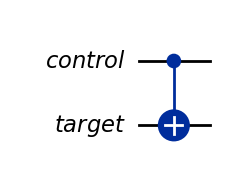
The unitary matrix for a CNOT gate is given below.
CNOT = Operator(qc_cnot)
CNOT.draw("latex")
# |00> -> |00> (reminder, little endian)
print((zero ^ zero).evolve(Operator(qc_cnot)))
# |01> -> |01> (reminder, little endian)
print((one ^ zero).evolve(Operator(qc_cnot)))
# |10> -> |11> (reminder, little endian)
print((zero ^ one).evolve(Operator(qc_cnot)))
# |11> -> |10> (reminder, little endian)
print((one ^ one).evolve(Operator(qc_cnot)))
Statevector([1.+0.j, 0.+0.j, 0.+0.j, 0.+0.j],
dims=(2, 2))
Statevector([0.+0.j, 0.+0.j, 1.+0.j, 0.+0.j],
dims=(2, 2))
Statevector([0.+0.j, 0.+0.j, 0.+0.j, 1.+0.j],
dims=(2, 2))
Statevector([0.+0.j, 1.+0.j, 0.+0.j, 0.+0.j],
dims=(2, 2))
Toffoli gate#
The Toffoli gate, notated CCX, is an example of a three qubit gate. A quantum gate \(G\) that acts on three qubits can be represented as a \(8 \times 8\) unitary matrix, i.e., \(G \in \mathcal{U}(8)\).
qc_ccx = QuantumCircuit(3)
qc_ccx.ccx(0, 1, 2)
qc_ccx.draw(output="mpl", style="iqp")

Operator(qc_ccx).draw("latex") # another advantage of quantum circuits ...
Multi-Qubit Circuits#
Similarly to single-qubit circuits, we can construct multi-qubit circuits out of single-qubit gates and multi-qubit gates. Multi-qubit gates can be sequenced and are reversible.
Property 1: Gates in parallel correspond to tensor product#
In a multi-qubit system, we can apply gates to different subset of qubits, i.e., in parallel. Below, we give an example where we apply an \(H\) gate to \(|q_0\rangle\) and a \(X\) gate to \(|q_1\rangle\).
# 2-qubit system
qc_xh = QuantumCircuit(2)
qc_xh.h(0)
qc_xh.x(1)
qc_xh.draw(output="mpl", style="iqp")
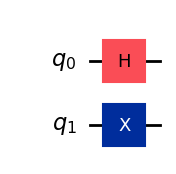
The unitary matrix that corresponds to the two qubit gate that acts on \(|q_1 q_0\rangle\) is given by \(X \otimes H\) where \(\otimes\) is the tensor product.
Aside: Tensor Product on Matrices#
Let
and
Then
Example worked put#
# Checking out our worked out example
Operator(qc_xh).draw("latex")
Property 2: Sequencing corresponds to matrix multiplication#
We can also sequence multi-qubit gates as we did with single-qubit gates.
qc = QuantumCircuit(2)
qc.h(0)
qc.x(1)
qc.cx(0, 1)
qc.h(1)
qc.h(0)
qc.draw(output="mpl", style="iqp")
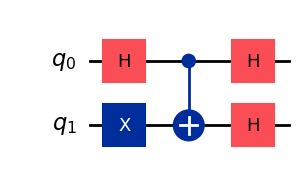
In matrix notation (again remembering little endian) … $\( qc = (H \otimes H) \, \text{CNOT} \, (X \otimes H) \)$
op = (X.tensor(H)).compose(CNOT).compose(H.tensor(H))
op.draw("latex")
np.allclose(Operator(qc), op)
True
Property 3: Reversability#
Recall that every unitary \(U\) has a conjugate transpose \(U^\dagger\) such that \(UU^\dagger = I\).
Fact: \((ABC)^\dagger = C^\dagger B^\dagger A^\dagger\).
Thus $\( ((X \otimes H) \, \text{CNOT} \, (H \otimes H))^\dagger = (H \otimes H)^\dagger \, \text{CNOT}^\dagger \, (X \otimes H)^\dagger \)$
# cnot is its own inverse
CNOT.compose(CNOT).draw("latex")
qc_rev = QuantumCircuit(2)
qc_rev.h(1)
qc_rev.h(0)
qc_rev.cx(0, 1)
qc_rev.h(0)
qc_rev.x(1)
qc_rev.draw(output="mpl", style="iqp")
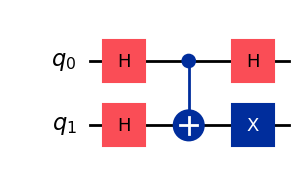
# Should be close to identity
np.allclose(Operator(qc_rev).compose(Operator(qc)), np.eye(4))
True
Entanglement#
Multi-qubit circuits enable us to construct entangled qubits which we can harness to leverage the exponential representational capacity of a a system of \(n\)-qubits without incurring an exponential number of operations. Before we give an example of how to entangle qubits with a multi-qubit circuit, we’ll discuss the situation where two qubits are not entangled in a multi-qubit system.
Non-entangled Computations#
As a reminder, two qubits are said to be entangled if they cannot be written as the tensor product of two single qubit systems. A multi-qubit circuit that acts on unentangled qubits can be thus be applied in parallel.
Example#
Suppose we run two single qubit systems that are run in parallel.
# 2 circuits in parallel
qc_h = QuantumCircuit(QuantumRegister(1, "q_0")); qc_h.h(0)
qc_x = QuantumCircuit(QuantumRegister(1, "q_1")); qc_x.x(0);
# Top part
qc_h.draw(output="mpl", style="iqp")
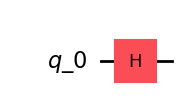
# Bottom part
qc_x.draw(output="mpl", style="iqp")
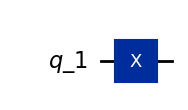
This is equivalent to this circuit from before.
qc_xh.draw(output="mpl", style="iqp")

# Checking that the tensor product of the circuits gives the original multi-qubit circuit
np.allclose(X.tensor(H), Operator(qc))
False
Constructing the Bell State: An Entangled State#
Recall the Bell state
was an entangled state. We can use a multi-qubit circuit to construct the Bell state, and thus, entangle two qubits.
qc_bell = QuantumCircuit(2)
qc_bell.h(0)
qc_bell.cx(0, 1)
qc_bell.draw(output="mpl", style="iqp")

(zero ^ zero).evolve(Operator(qc_bell)).draw("latex")
Summary#
We introduced multi-qubit gates, including the CNOT gate.
We saw that a multi-qubit circuits can be used to entangle qubits.
